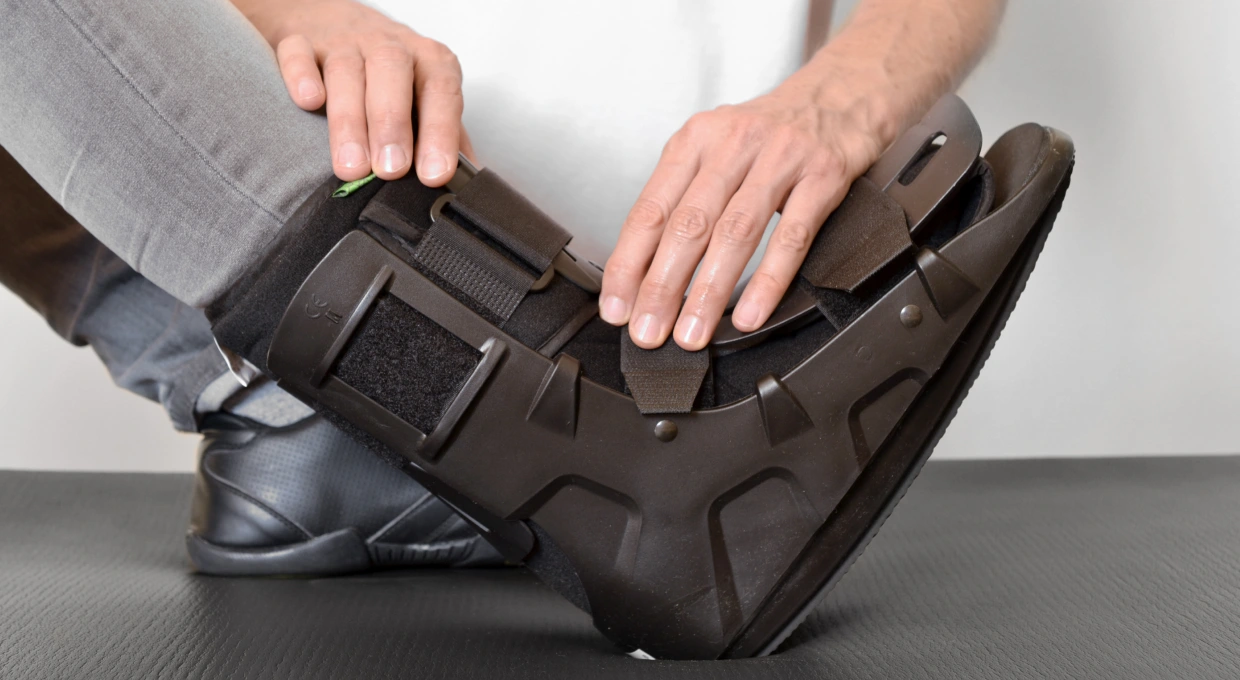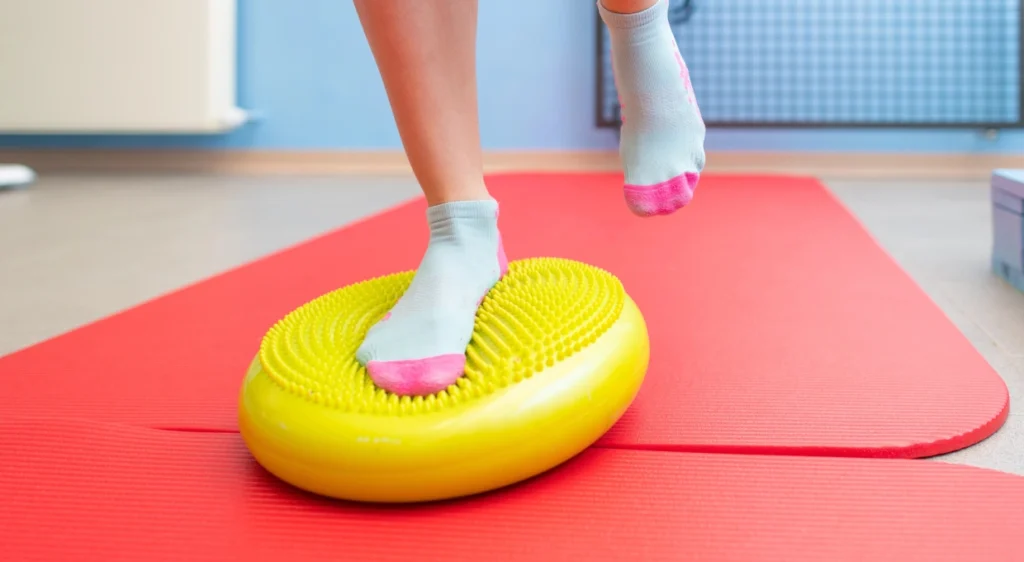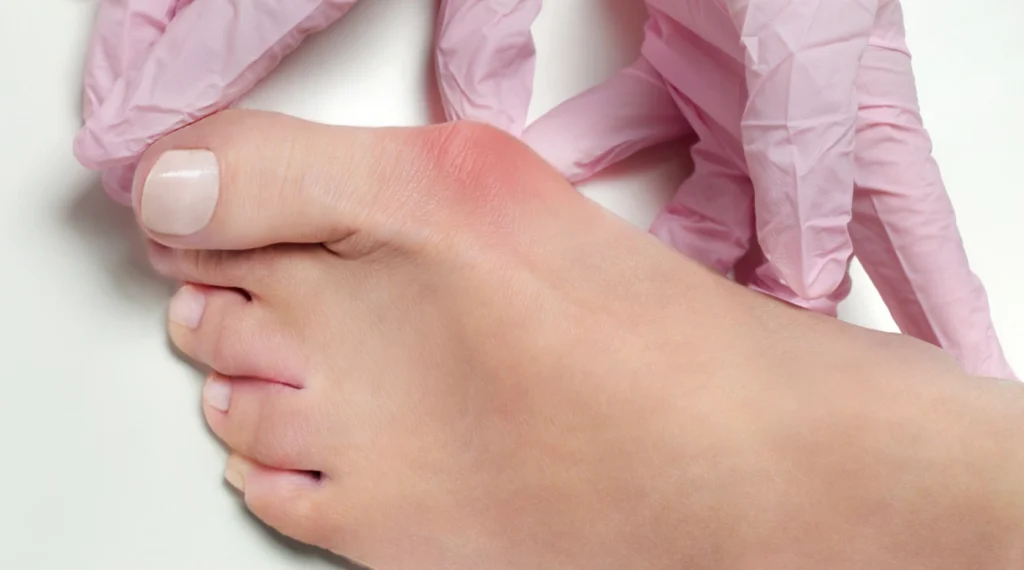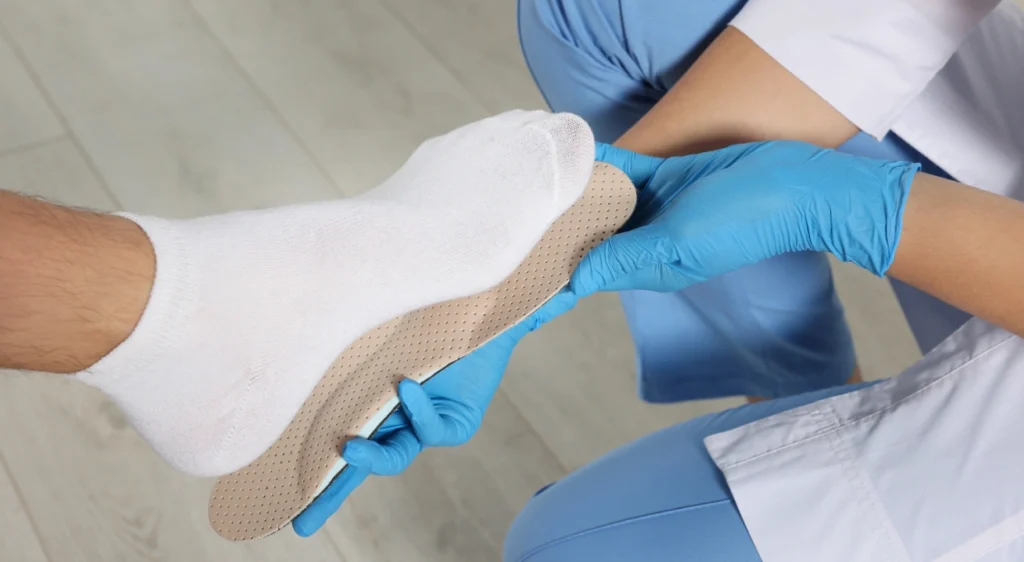One of the most frequently asked questions after bunion surgery is: what shoes can I wear during recovery? The right footwear in each postoperative phase not only influences your comfort, but is essential for proper bone healing, prevention of complications and optimal long-term results.
In this article we explain, phase by phase, what type of footwear you will need after your hallux valgus surgery, based on established medical protocols and our experience with more than 3,000 surgeries at Clínica San Román.
Why Postoperative Footwear Is Important
After bunion surgery, the bone has been realigned by means of osteotomies (controlled cuts) that need to consolidate properly. Post-surgical footwear serves essential functions:
- Protection of the operated area against shocks or traumatisms.
- Controlled load distribution during walking
- Reduction of pressure on the osteotomy site
- Maintenance of the correction achieved surgically
- Prevention of edema (swelling) by adequate containment
- Facilitating safe early ambulation
Wearing the wrong footwear at each stage can compromise bone healing, increase pain, cause persistent edema or even promote recurrence of the deformity.
Phase 1: Days 0-6 Weeks – Rigid Post-Surgical Footwear
Features of Immediate Postoperative Footwear
During the first 4-6 weeks after surgery, it is essential to wear a specialized post-surgical shoe, also known as a forefoot offloading shoe. This shoe has specific characteristics:
Rigid rocker sole (rocker sole):
- Allows gait without flexing the operated metatarsophalangeal joint
- distributes the load to the rearfoot and midfoot area
- Facilitates progress during walking without compromising the surgical site
Wide and padded toe:
- Sufficient space to accommodate postoperative dressings
- Avoid direct pressure on the operated area
- Allows physiological edema without compression
Adjustable closure (Velcro or wide drawstring):
- Allows adjustment according to edema evolution
- Facilitates placement and removal without forcing the operated foot.
Breathable material:
- Reduces sweating and maintains hygiene
- Reduces risk of skin maceration
How to Wear Post-Surgical Footwear
Ambulation from the first day: You will be able to walk with support of the heel and external area of the foot, avoiding the complete load of the forefoot. It is essential:
- Take short, controlled steps
- Keeping the shoe on during the whole ambulation
- Use canes or crutches for the first few days if recommended by your surgeon.
- Limit walking to what is strictly necessary (bathing, meals).
Rest with foot elevated: When at rest, keep the foot elevated above the level of the heart to reduce edema. Footwear should only be worn for walking.
Footwear hygiene:
- Regularly clean the sole with a damp cloth.
- Ventilate the interior daily
- If the model allows it, wear clean cotton socks.
Duration of Use
The standard duration is 4-6 weeks, but may vary according to:
- Type of surgical technique used
- Severity of the corrected deformity
- Bone quality of the patient
- Individual evolution of consolidation (assessed radiologically)
Do not abandon post-surgical footwear without medical authorization. Even if you feel fine, bone healing requires this minimum time.
Phase 2: Weeks 6-12 – Transition to Sports Shoes
Transitional Footwear Characteristics
Once your surgeon confirms by radiological control that the initial consolidation is adequate, you can begin the transition to conventional footwear. During this phase (weeks 6-12), the ideal footwear should meet the following requirements:
Wide tip:
- Minimum 1 cm of space between the longest toe and the toe of the shoe
- Wide last that does not compress the forefoot laterally
- Avoid pointed or narrow shoes altogether.
Supportive yet flexible sole:
- It should allow natural flexion of the foot
- With good cushioning (EVA, gel or viscoelastic foam)
- Avoid completely flat or very stiff soles.
Adequate support of the rearfoot:
- Firm heel counter
- Laces or Velcro for customized fit
- Prevents excessive lateral movements
Breathable materials:
- Mesh, technical textiles or quality leather
- Avoid non-breathable synthetic materials
- Reduces the risk of chafing on even sensitive skin
Moderate heel lift (drop):
- Between 4-8 mm heel-toe difference
- Reduces tension in the posterior musculature
- Avoid high heels or completely flat shoes
Types of Footwear Recommended for this Phase
Quality sneakers:
- Running or training by specialized brands
- Models with wide tip (wide fit or extra wide)
- Examples: ASICS Gel series, New Balance Fresh Foam (wide), Brooks Ghost, Hoka Bondi
Casual sports footwear:
- Sneakers with cushioned sole
- Brands with comfort lines (Skechers, Ecco, Clarks Active line)
Orthopedic sandals (warm weather):
- With plantar arch support
- Adjustable instep and ankle fastening
- Contoured and cushioned sole
- Examples: Birkenstock, Vionic, Reef Orthotic
What to Avoid Absolutely
❌ Heeled shoes (any height over 4 cm)
❌ Ballerinas or ballet flats (no structural support)
❌ Pointed or narrow-heeled shoes
❌ Flip-flops or flip-flops (no rearfoot support)
❌ Stiff or new unadapted shoes (risk of chafing)
❌ Shoes with very worn soles (alters biomechanics).
Transition Tips
Gradual progression:
- Start wearing the new footwear 1-2 hours a day.
- Progressively increases the time of use
- Alternate with post-surgical footwear if discomfort occurs.
- Always have your postoperative shoe at hand during the first weeks of surgery
Tolerance assessment:
- Slight discomfort at the beginning is normal
- If severe pain, swelling, or redness develops, consult
- Check skin daily for chafing.
Use of insoles: In some cases, your podiatrist may recommend custom insoles during this phase for:
- Redistributing pressures
- Correct associated biomechanical alterations
- Protect the operated area during adaptation

Phase 3: Months 3-6 – Expansion of Options
Progressive Incorporation of Everyday Footwear
From the third month, with medical authorization and according to individual evolution, you can gradually begin to incorporate more varied footwear:
Footwear for daily use:
- Soft leather shoes with comfortable last
- Moccasins with cushioned insole
- Low-top lace-up ankle boots
For work:
- Closed shoes in supple leather
- With removable insole for customized support
- Non-skid sole if you work standing up
Specific activities:
- Hiking: trekking boots with good support (after 4-5 months)
- Gym: specific shoes according to activity
- Swimming: booties if the pool allows it
Selection Criteria in this Phase
Although the options are expanding, keep these criteria:
✓ Generous last in forefoot area
✓ Quality materials that yield slightly
✓ Good support without excessive pressure points
✓ Outsole with adequate cushioning
✓ Moderate heel height (maximum 4-5 cm).
When You Can Wear More Aesthetic Footwear
Occasional dress shoes: From the fourth month, for occasional events and for a limited time, you can wear:
- Dress shoes with wide last
- Low (3-4 cm maximum) and wide heel (no stiletto)
- Only for special occasions, maximum 2-3 hours
- With gel insole for greater comfort
Important precautions:
- Don’t wear high heels on a regular basis before 6 months
- Listen to your foot: if it hurts, change it.
- Always wear comfortable spare footwear
Phase 4: Month 6 Onward – Back to Normal (with Nuances)
Complete Shoe Recovery
After 6 months, most patients have reached full consolidation and can return to their usual footwear with certain long-term recommendations.
What you can already do:
- Wearing regular dress shoes
- Resuming sports with appropriate specific footwear
- Alternate between different types of shoes according to activity
Recommendations for life:
Although surgery has corrected the deformity, maintaining good footwear habits prevents recurrences and cares for the health of your feet:
Prioritizes comfort over aesthetics:
- Choose quality footwear with noble materials
- Reserve narrow shoes or high heels for occasional occasions only.
- Daily use should be with comfortable and functional shoes.
Characteristics of healthy footwear:
- Wide tip to allow natural finger movement
- Firm but not rigid buttress
- Flexible sole in metatarsal area
- Moderate drop (4-10 mm)
- Breathable materials
Avoid prolonged use of:
- Heels higher than 5 cm (maximum 2-3 hours occasional)
- Completely flat shoes (ballerina type)
- Narrow or pointed shoes
- Slip-on flip-flops as regular footwear
Warning Signs
Even after full recovery, consult your podiatrist if you observe:
- Reappearance of pain in the operated area
- Persistent redness or swelling
- Calluses in new areas
- Sensation of the finger going astray again
- Increasing difficulty to put on shoes
Activity-Specific Recommendations
For Work
Office work (sedentary):
- Incorporation: 2-3 weeks with post-surgical footwear
- Recommended footwear: comfortable closed shoes, cushioned moccasins
- Tip: keep sneakers under your desk for changing.
Standing work (commerce, hospitality):
- Incorporation: 6-8 weeks, according to evolution
- Recommended footwear: professional shoes with gel insole, non-slip soles
- Tip: wear light compression stockings to reduce edema.
Working with safety footwear:
- Incorporation: 8-12 weeks
- Recommended footwear: safety boots with a wide last, customized insole
- Tip: consult your occupational physician about temporary accommodations.
For Sports
Walking/Hiking:
- Start: from 6-8 weeks on flat ground, gradual progression
- Footwear: trail running shoes or light trekking boots
- Distance: increase 10-15% weekly
Running:
- Start: 3-4 months (after medical control)
- Footwear: running shoes with good cushioning, correct sizing
- Progression: start with gentle jogging, regular surfaces.
Gym/Fitness:
- Start: 2-3 months for low impact exercises
- Footwear: training shoes with lateral support
- Caution: avoid high-impact exercise until 4-5 months
Racquet sports/dance:
- Start: 4-6 months
- Footwear: activity-specific, with good lateral support
- Progression: start with short, low-intensity sessions.
Swimming:
- Onset: 4-6 weeks (consult wound closure)
- Footwear: neoprene booties if the swimming pool allows it
- Benefit: excellent unloading activity for recovery
Practical Tips for Choosing Your Footwear
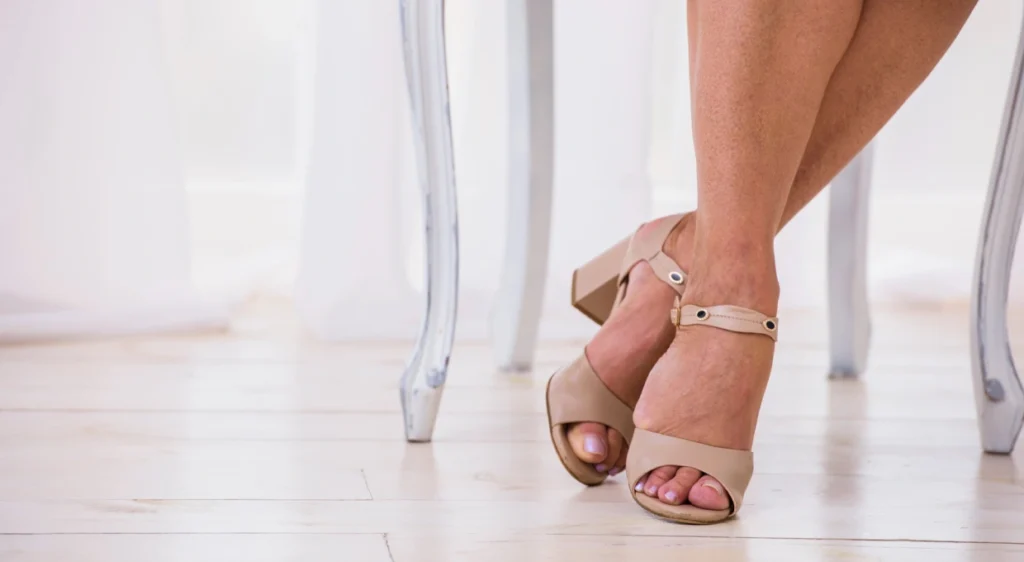
How to Know if a Shoe is Suitable
Toe test: With the shoe on and standing upright, there should be one toe of space (1-1.5 cm) between your longest toe and the toe of the shoe.
Width test: The sides of the shoe should not compress the foot. You should be able to move your toes slightly horizontally.
Flexion test: The shoe should flex in the forefoot area (metatarsals), not in the center of the arch.
Heel counter test: Press the heel part: it should be firm but not excessively rigid.
Gait test: Walk at least 5-10 minutes in the tent. It should be comfortable from the first moment.
Common Mistakes in Choosing Postoperative Footwear
❌ Buying one size down thinking it will “fit”
❌ Choosing for aesthetics ignoring comfort
❌ Wearing old shoes that are badly worn (altered biomechanics)
❌ Not trying on socks similar to the ones you will wear
❌ Buying in the afternoon-evening when the foot is less swollen
❌ Reusing old shoes that caused previous problems.
Best Time to Buy New Shoes
- In the afternoon: the foot is slightly more swollen (similar to after walking).
- With usual socks: to assess the actual fit
- After a short walk: simulates real-use conditions
- In specialized stores: with professional advice
Additional Care of the Operated Foot
In addition to footwear, other care is needed to promote optimal recovery:
Appropriate Socks
- Material: cotton or breathable technical fibers (avoid 100% synthetic)
- Seams: flat or seamless in the toe area
- Compression: light to moderate, no tight ankle elastics
- Height: according to footwear, avoiding wrinkles that may rub.
Templates and Supports
Your podiatrist can prescribe:
- Custom insoles: to correct biomechanical alterations
- Finger spacers: silicone, for night use (if indicated)
- Metatarsal pads: to redistribute pressures
Moisturizing and Skin Care
- Moisturize daily with specific foot cream
- Pay attention to areas of rubbing or redness.
- Keep nails short and filed straight across.
- Checks between the fingers for chafing
Frequently Asked Questions about Postoperative Footwear
Can I wet my post-surgical footwear?
The inside should be kept dry to avoid macerating the skin and compromising the bandages. Clean only the outside with a damp cloth. If it accidentally gets wet, dry it completely before reuse.
Do I need to buy two pairs of post-surgical footwear?
It is not essential, but it can be practical if the surgery is in wet season or if your activity requires frequent displacements. One can be ventilated while you use the other.
Can post-surgical footwear be worn on both feet?
Some models are universal (valid for right and left foot), others are specific. Check when purchasing if you will be operated on one foot or both (at different times).
Can I drive with post-surgical footwear?
It depends on the operated foot:
- Left foot: you can generally drive from 2-3 weeks (automatic) or 6-8 weeks (manual).
- Right foot: NO driving until at least 6-8 weeks and always with sport shoes (never with post-surgical).
Always consult with your surgeon and insurance company before resuming driving.
What do I do if my shoes rub or cause discomfort?
- Consult your podiatrist: he/she can adjust the bandage or the footwear.
- Do not use the foot “barefoot”: always wear a sock.
- Apply protective dressings (Compeed type) on rubbing areas.
- Never ignore chafing: it can become infected.
Is post-surgical footwear covered by medical insurance?
It depends on your policy and type of surgery (public/private). In many cases it is included in the price of the intervention or it can be prescribed for purchase in orthopedics. Previous consultation.
Can I wear sandals in summer after surgery?
First 6 weeks: NO, you must wear closed post-surgical shoes.
6-12 weeks: Orthopedic sandals with support (Birkenstock, Vionic) for limited use at home.
After 3 months: Quality sandals with support, avoiding flip-flops without support.
Will my pre-surgery shoes fit me afterwards?
Depends:
- Comfortable, wide shoes: probably yes, after 6 months
- Narrow or high heeled shoes: they may no longer be comfortable (good sign, your foot is healthier!)
- Deformed shoes: discard them, they perpetuate the deformity.
Conclusion
Proper footwear is a fundamental pillar in your recovery after bunionette surgery. Respecting the phases and recommendations not only guarantees optimal consolidation, but also prevents complications and favors long-lasting results.
Remember:
- First 4-6 weeks: rigid post-surgical footwear only.
- 6-12 weeks: progressive transition to wide, comfortable sneakers
- 3-6 months: gradual expansion of options
- 6 months onwards: back to normal with healthy footwear criteria
Investing in quality footwear during and after recovery is not an expense, it is an integral part of treatment. Good footwear protects your investment in health and wellness.
Consultation with Specialists in Alicante
At San Roman Clinicwe accompany our patients in every phase of recovery, including personalized advice on postoperative footwear. If you have doubts about what shoes to wear after your bunion surgery, our team is available to guide you.
Medical note: The recommendations in this article are indicative. The times and types of shoes may vary according to the surgical technique used, severity of the corrected deformity and individual evolution. Always follow your surgeon’s specific instructions.
